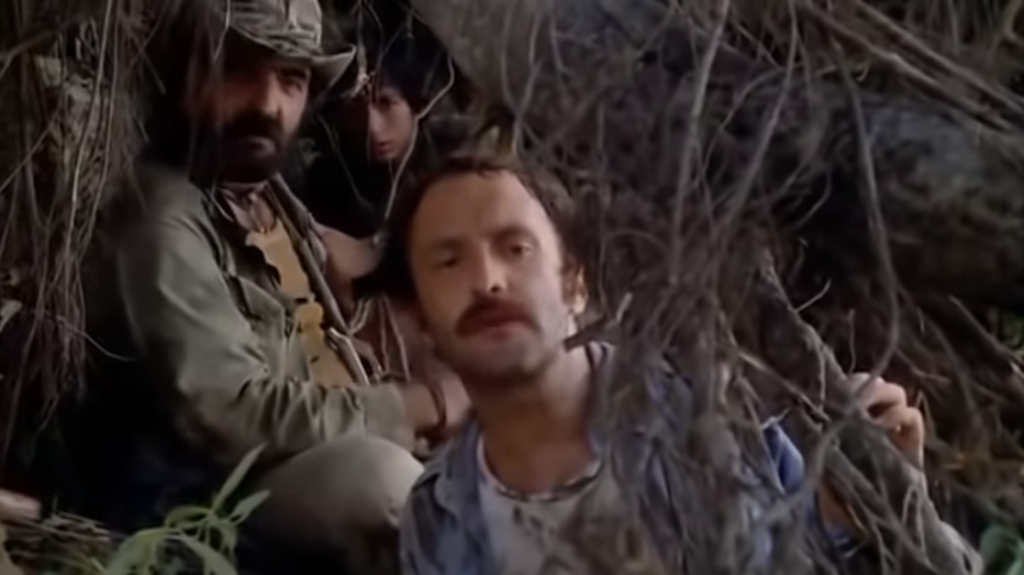cannibal holocaust
1980

Rated: NR
Genre: Horror
Country: Italy
Run-Time: 1h 35min
Director: Ruggero Deodato
Cast
Robert Kerman……………..Professor Harold Monroe
Carl Gabriel Yorke…………Alan Yates
Francesca Ciardi……………Faye Daniels
Salvatore Basile……………..Chaco Losojos
First off, let me say that before seeing Cannibal Holocaust, I assumed that it never really had a chance of making this list. I had personally always written it off as being a dumb exploitation film that occasionally got mentioned for inspiring the found footage genre. But when I saw it was available for free on Kanopy -the best part of having a library card -curiousity got the better of me. Thank god. Even though Cannibal Holocaust is inarguably an exploitation film, I was surprised by how remarkably self-aware the film is and by its powerful, rather redeeming, anti-imperialist message. Director Ruggero Deodato is a genius.
But before I get into the plot, I should clear up a common misconception about this film. Cannibal Holocaust is not a pure found footage film. It is more of a narrative film/found footage hybrid, like Sinister, where a man acquires some very questionable film footage and ponders what to do with it. Only, unlike Sinister, the found footage portions of this film tell a single story, acting as a sort of film within the film that takes up most of the back half of this movie. And this found footage section is horrendous. But it is also brilliant. And nobody in today’s current climate could ever get away with filming footage like this, which includes real animals being slaughtered. Of course, Deodato did not exactly get away without consequences in his time either; but when his film screened in the 80s, the outrage had little to do with the animals.
Today, the film’s blatant cruelty towards animals- including one particularly infamous scene with a turtle- remains the film’s biggest controversy.
Cannibal Holocaust is about an anthropologist named Harold Monroe who ventures into African rainforest in search of four missing documentary filmmakers. The filmmakers had set out into the heart of The Green Inferno to film some of the last remaining “primitive” peoples on Earth. Monroe’s motives are pure, as the lost film crew has become a big story in the United States and Monroe hopes they could still be alive. But to succeed in his mission, Monroe has to team up with some unsavory characters, including his unscrupulous guide and a captured “savage” they are exchanging for information.
Of all the films recommended for The Midnight Selections, those first minutes of this film are the most abysmal in terms of quality, excluding those incredible long shots of the jungle from the plane. But I urge you to put up with it. The acting at the start of the film is rough and when members of the indigenous Yacumo tribe get shot by the state military, there is just no believability to the bloodless bullet wounds. The whole sequence looks amateurish, and in stark contrast to the realism will come. I like to deluge myself into thinking this was by design, but that’s giving director Deodato too much credit. (The worse looking scenes are not really needed anyways, so somewhere I like to think there is a perfect fan edit that removes all the garbage from the opening.) There is, however, a sad point the film makes in these scenes. Western interference has resulted in an atrocity. For Monroe to fulfill his mission, the State has captured a member of the Yacuma tribe alive, but this has led to the death of many others.
Soon we learn that what the State has gone for Monroe doesn’t jive with his own sense of morality. Monroe is shown as someone who, had he known, would not have approved of this massacre. But that he couldn’t predict the State’s methods for assistance reveals Monroe’s American naivety.
But soon, the quality of the film greatly improves, especially after Monroe meets with the Yacumo tribe. At this point, viewers act as witnesses to the brutal murder of a woman in an infidelity ritual before meeting the Yacumo community, who we are told are tame in comparison to the warring Yanomamo and Shamatari tribes. But for me, the first hint that Cannibal Holocaust was a special film with something new to offer came when they show a jungle ambush between these two tribes that are referred to as the jungle’s “superpowers”.
There is a fascinating sense of realism to many of the scenes in the first half of Cannibal Holocaust, but they are interspersed between scenes of obvious camera trickery. At one point, we see a tiger that the group must shoot at to scare it off, but we never see the group or the tiger in the same shot. Shots like this are clearly inauthentic. But in another scene, we see many Yanomamo, often referred to as the “tree people”, hanging out on a fascinating structure when an exotic bird flies from its perch, circles around, and comes back. Here, the cinematography is marvelous. How did they get a free bird to feel safe so close to so many people? It is astonishing.
But the first half of Cannibal Holocaust is only a prelude to the hyperrealism to come. When Monroe returns to the U.S., the story pivots. Monroe returns knowing what happened to the missing documentary crew, but he wants to know why. The hope is that their story is by told the recovered reels. But those reels are owned by a film studio who funded Alan’s project.
Hold on. Now things are now about to get crazy meta.
The studio executives show Monroe excerpts of Alan’s previous work, The Last Road to Hell, which depicts a series of Nigerian executions. From this point on, Cannibal Holocaust transforms into something closer to the notorious Faces of Death, which everyone my age watched in their teens, though none of us legally should have. When people are shot in Alan’s the Last Road to Hell, we now see the bullet holes. There is a heightened reality to this footage- because it is real footage! Ruggero Deodato sliced together actual stock footage of political executions to make this fictional documentary. Then we are told by the film’s producers that the executions were partially staged. Alan paid the military to kill rebels in ways that would cause the maximum effect for his audience because back home violence sells.
As I said, it is extraordinarily meta. And it is not the type of intelligence you would expect to find in a film that found itself banned in several countries for being “a snuff film”. (Yet, as a kid, I got to see Faces of Death?)
But the film’s final brilliant act shows us what is on those reels Monroe recovered and honestly, this part of the film is mandatory viewing for found footage enthusiasts. (It is also where the film gains most of its notoriety.) Normally I do not like to play spoiler, but I will say that Alan’s tale is a horrific moral tale. He acts as devil to the Yacumo, but when he begins to act horrible to Yanomamo, he finds that their group will have none of it. You will be hard pressed to find four more deserving deaths caught on screen.
The stylistic contrast between the movie and those “found footage” reels is striking. The film’s often marginal acting also shows stark improvement during these scenes. Animals are “actually” mutilated. People are believable mutilated to the point where Deodato was arrested shortly after the Italian premiere for filming, what many believed to be, real murders. (The film was seized and banned in most European countries 10 days after release. However, it was also, for a while, the second highest grossing film in Japan behind only E.T.. You just can’t make this stuff up.) The horrors are visceral and extreme and occasionally conjure up feelings of watching the worse scenes of The Last House on the Left.
When you get to the end of Cannibal Holocaust, you might be surprised at how little the film has to do with cannibalism. If anything, the film has far more to say about how real atrocities are exploited by the people who capture them on film. Rocher delivers the ultimate imperialism revenge fantasy. It is nasty. It is itself exploitive. And it is a much better, more moral (minus the killing of animals), and a far more self-aware film then I could have ever imagined.
Cannibal Holocaust is a true adult horror masterpiece that, honestly, probably is best off remaining in the cult margins. I cannot justify the animals slaughtered for the sake of film, but even still, I would hate to see the film pushed aside entirely as our society becomes more willing to censor what came before. This is an important film in cinema
